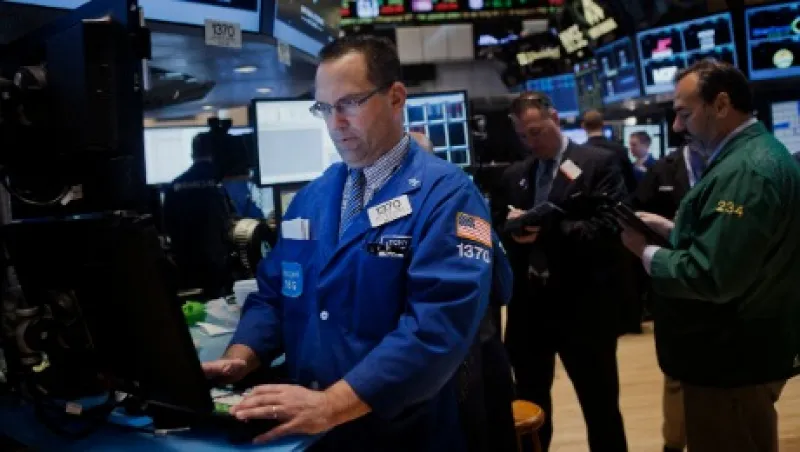The risk-on camp appears to be in charge this morning, as both crude oil and U.S. equity index futures are rising after a steep sell-off yesterday for stocks. With most watchers of U.S. dollar-denominated markets focused on the employment report, due from the U.S. Department of Labor on Friday, expectations for the pace of Federal Reserve tightening remains the primary driver of market sentiment across assets. Meanwhile, as for the world’s second-largest economy, David Rosenberg, chief market strategist at Gluskin Sheff in Toronto, wrote in a research note for clients that for all the talk of a slowdown in China, “at 7 percent growth, the country still adds more to global GDP than it did a decade ago at double digits.”
European services PMI rises. Final April services and composite purchasing manager index levels released today by Markit demonstrated resilience in nonmanufacturing sectors, with aggregate levels for the common currency area registering at 54.1 bringing the euro zone’s combined services and manufacturing composite reading to 53.9. Perhaps the most striking data point in the PMI reading released today was the service industry index for Spain, which rose to 60.3. This strong reading, coming on the heels of a positive surprise in first-quarter 2015 GDP and a fall in unemployment numbers, suggests that the Spanish economy is now in rapid recovery mode.
BMW earnings best forecasts. Munich–headquartered BMW, the world’s largest luxury car brand by units sold, today reported results for the first three months of 2015 that came in well above consensus analysts’ estimates. At $2.8 billion, earnings increased by more than 20 percent versus the same period last year, joining the other two primary German automotive companies Volkswagen and Daimler in benefiting from a weaker euro and recovering demand in North America and Europe, which has offset slowing sales growth in China.
Greek unemployment drops slightly. A modest contraction in the headline unemployment rate to 25.4 in February, the lowest level since 2012, is insufficient to relieve pressure on the administration of Greek Prime Minister Alexis Tsipras as he comes under pressure to deliver on campaign promises to resolve his nation’s debt crisis on his Syriza party’s own terms. Separately, Greece today met a €200 million ($225 million) debt repayment obligation to the International Monetary Fund. A significantly larger payment is due May 12, which most analysts anticipate that the government in Athens will be unable to advance without first securing an extension from European Union creditors.
China services PMI hits multimonth high. Final April nonmanufacturing purchasing manager data for China released today saw the headline index reach a four-month high of 52.9. Despite the rebound, the prices for services subindex slipped to a 15-month low of 49.2 and employment rose only modestly, as service sector businesses face steep competition in the face of overall weakened demand.
Oil prices rise despite supply data. In advance of the Energy Information Administration crude oil inventory report to be released today, West Texas Intermediate crude oil futures contracts for June delivery rose above $62 per barrel in electronic trading this morning. Analysts’ consensus forecasts are for an increase in stockpiles, despite figures showing more capacity coming offline in North America in response to the supply glut reported over the past four months. A private measure released yesterday by the American Petroleum Institute indicated a contraction in reserves stockpiled in Cushing, Oklahoma, a major oil trading hub.
Yellen to speak at conference. Federal Reserve Chair Janet Yellen will address the Institute for New Economic Thinking in the Conference on Finance and Society in Washington today. Given the topic, it is likely that some discussion of labor markets will be included in her presentation, as well as possibly some factors outside the Fed’s mandate, such as income inequality.
Earnings season continues. This morning primary French banks Société Générale and Crédit Agricole each released earnings for the first three months of the year that exceeded analyst estimates. Société Générale’s $970 million in earnings represents a five-fold increase over the same period in 2014, when the bank was forced to write down Russian asset values, A pickup in asset management and investment banking activity were key drivers for the income growth. U.S. insurer MetLife will announce first-quarter results after equity markets close this afternoon. Expectations among analysts are that the company’s recent major push to increase annuity sales will be a primary driver of profits for the period. Tesla Motors will also report after the close. Investment bank Jefferies yesterday resumed coverage of the performance electric car manufacturer with a “buy” rating and a price target of $350 per share.
Portfolio Perspective: A Shaken Bond Market May be a Buying Opportunity — Karl Haeling, Landesbank Baden-Württemberg
On one hand, investors are busy trying to understand the nature and implications of the big sell-offs in global bond markets this past week. On the other hand, the market now faces what appears to be another concentrated burst of supply immediately ahead. Both elements are short-term bearish and have left the market somewhat shaken.
U.S. investment-grade bond issuance is expected to total between $120 billion and $140 billion in May, with much of it occurring in the first half of the month ahead of the Memorial Day holiday weekend. Issuance totaled $107 billion in April, with most of that amount allocated in the final two weeks of the month. The record for any single month is $143 billion, so May stands to be one of the busiest months ever for the asset class. It is also noteworthy that much of the expected supply will involve long-dated paper — and thus a lot of duration for the market to absorb in a short period of time. Given that most of the supply to involve corporate issuers rather than financial ones, there will be relatively little associated swapping, another near-term negative for Treasuries.
In the middle of this issuance, Treasury will come to market May 12-14 with an expected $64 billion of auctions involving three-, ten- and 30-year paper, a further worry for near-term market direction.
Ironically, all the new issuance globally, whether from corporates or sovereigns, is not producing any net new supply, as there is so much maturing debt. So supply of investment liquidity is not the issue. There is plenty of money to absorb the paper.
The problem is the timing and the growing illiquidity of the markets. Money managers typically sell out older corporate bonds from their portfolios to make room for the new issues. Yet with dealer balance sheets now so limited, it is difficult for the secondary market to absorb the associated redistributions. This only adds to the hedge pressure.
In the end, however, this just creates a good buying opportunity, as money eventually flows in to take advantage of what essentially becomes a giant new issue concession for the whole marketplace. This can be seen in Treasuries, where the government is scheduled to make $67 billion of maturing debt payments on May 15, $3 billion more than the expected size of the mid-month auctions.
Karl Haeling is a vice president of capital markets at Landesbank Baden-Württemberg’s New York office.






